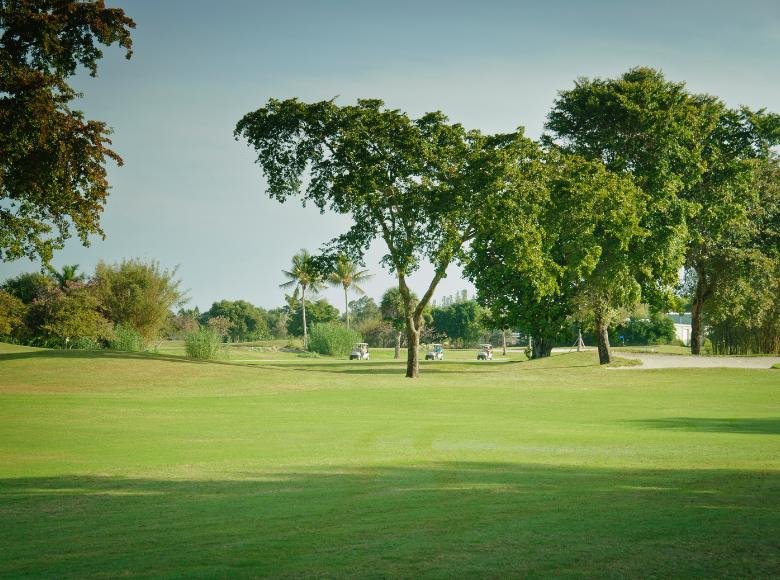Elevating the aesthetics, playability, and health of Florida golf courses, overseeding emerges as a crucial practice, offering enhanced aesthetic appeal, consistent playing surfaces, soil stability, weed suppression, and temperature regulation, ensuring year-round vitality and performance.
Golf course maintenance in Florida is a nuanced task, especially when gearing up for the winter season. Overseeding emerges as a critical practice in ensuring that golf courses maintain their lush green appearance even in the cooler months.
Let’s delve into the essential role of overseeding in preparing Florida golf course grass for winter.
Role of Overseeding in Preparing Florida Golf Course Grass
1. Enhancing Aesthetic Appeal:
Florida is known for its warm climate, but even in the Sunshine State, winter can bring about changes in the color and health of the grass. Overseeding involves planting cool-season grasses, such as ryegrass, over existing warm-season grasses, like Bermuda or Zoysia. This strategic addition not only provides a vibrant green hue during the winter but also ensures that the golf course maintains its visual allure throughout the year.
As the cool-season grasses take center stage, the golf course transforms into a canvas where every blade contributes to the overall aesthetic composition. The deliberate interplay of colors not only enhances the allure of the course but also signifies a commitment to providing golf enthusiasts with an enchanting visual experience throughout the winter months. It’s not just about maintaining green fairways; it’s about curating a living masterpiece that captivates and elevates the entire golfing experience in the heart of Florida’s winter.

2. Maintaining Playability:
Beyond aesthetics, overseeding plays a crucial role in preserving the playability of the golf course during winter. Warm-season grasses may go dormant or experience discoloration in colder temperatures, affecting the overall quality of the playing surface. Overseeding with cool-season grasses helps to counteract this, providing a resilient turf that can withstand the winter conditions and maintain a consistent playing experience for golf enthusiasts.
The meticulous process of overseeding aims not just for a cosmetic transformation but for a functional one. Maintaining playability is about ensuring that every swing, every putt, and every round feels familiar and enjoyable for golfers.
The cool-season grasses, with their adaptability to lower temperatures, act as a reliable partner, preserving the resilience and texture of the turf. The result is a golf course that beckons golfers to experience the joy of the game, regardless of the season, fostering a connection between players and the course that transcends the shifts in weather.
3. Soil Health and Erosion Control:
Overseeding is not just about the grass; it’s also about the health of the soil. The additional layer of cool-season grass helps prevent soil erosion during winter rains, ensuring that the topsoil remains intact and conducive to healthy turf growth. This practice contributes to the overall stability and sustainability of the golf course landscape.
The dense growth pattern and robust root systems of these grass varieties help bind the soil particles together, reducing the risk of runoff and soil loss. This not only preserves the integrity of the golf course landscape but also contributes to the overall health of the soil ecosystem. By safeguarding against erosion, overseeding becomes a steward of the foundational elements that support the vibrant greenery, creating a harmonious balance between the aesthetics of the course and the sustainability of its ecological base.
4. Weed Suppression:
By overseeding with desirable grass varieties, the golf course management team actively suppresses the growth of unwanted weeds. Cool-season grasses, when strategically introduced, create a dense turf that inhibits the germination and establishment of weeds. This not only adds to the visual appeal of the golf course but also minimizes the need for excessive herbicide use.
5. Temperature Regulation:
Florida winters may not be as harsh as in some other regions, but temperature fluctuations can still impact the health of warm-season grasses. Overseeding provides a buffer by introducing grass varieties that thrive in cooler temperatures. This aids in maintaining a more stable microclimate on the golf course, preventing sudden shocks to the existing grass and promoting a gradual transition between seasons.
The role of overseeding in preparing Florida golf course grass for winter goes beyond aesthetics; it’s a comprehensive strategy for ensuring year-round vitality and performance. Golf course managers and superintendents keen on providing an exceptional golfing experience in every season recognize overseeding as a key practice in their maintenance playbook. So, as winter approaches, the vibrant green fairways of Florida golf courses stand as a testament to the thoughtful and strategic approach of overseeding.
Transform your golf course into a year-round masterpiece with DTE Golf®’s expert course maintenance services. Elevate the aesthetics, enhance playability, and promote soil health. Partner with us to ensure your Florida golf course remains a lush haven even during winter. Contact DTE Golf® today to bring professional excellence to your golf course maintenance.
